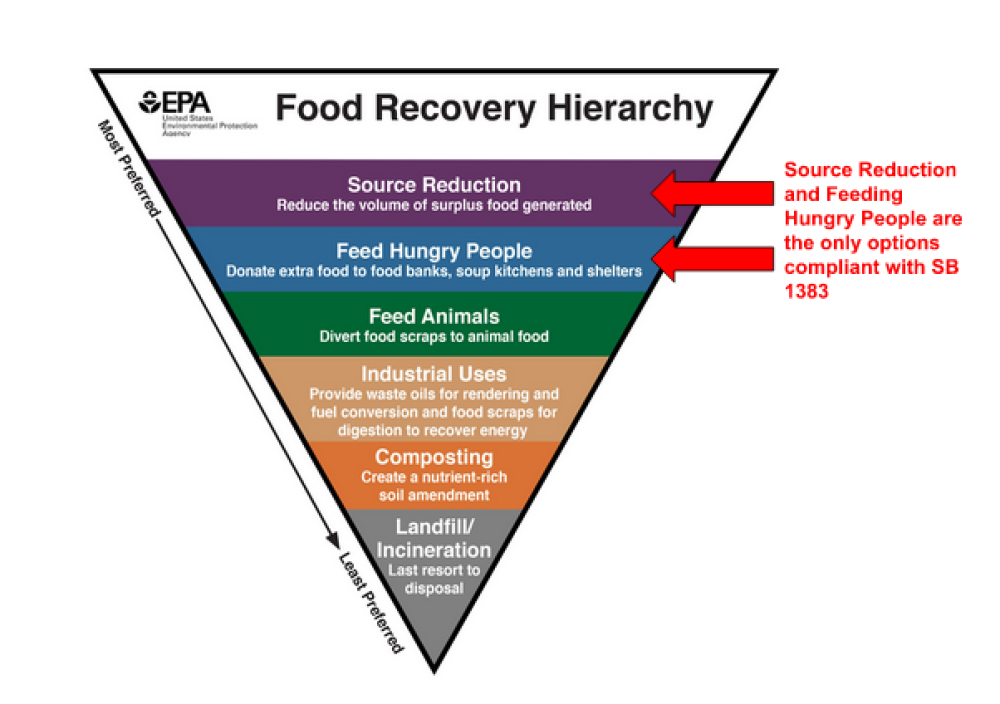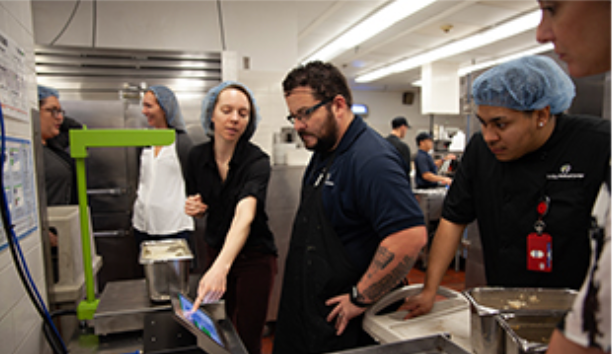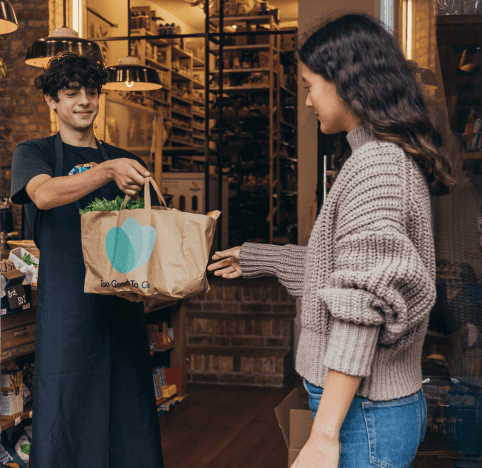Prevent Food Waste
About 40% of food produced in the United States goes to waste each year, with Californians throwing away nearly 6 million tons of food waste annually. Food waste is a big problem that can be mitigated with your help! While Food Recovery is important for the surplus edible food that you do generate, there are many opportunities for you to prevent surplus edible food in the first place. The EPA suggests that prevention is the best way to tackle food waste.

Make Surplus Available to Staff
Food service workers spend their day surrounded by food but often aren’t able to afford to purchase from the shelves they stock. A 2022 study done by the Economic Roundtable and United Food and Commercial Workers Union found that 78% of grocery workers they represent experience food insecurity. (That number jumps to a staggering 85% among single parents.)
Food generating businesses with new SB 1383 food recovery requirements may provide their surplus edible food directly to their staff. A robust surplus-to-staff program prevents waste, encourages employee retention, and will help you comply with SB 1383’s edible food recovery requirements by reducing or eliminating the need for regular surplus food pick ups by food recovery organizations.
Businesses and organizations that provide surplus to end recipients receive the same liability protections they would if providing that food to a nonprofit organizations under the 2023 Federal Food Donation Improvement Act.
Prevention Tips & Resources
Supermarkets, grocery stores, and the restaurant industry collectively spend billions of dollars on food waste costs each year. In the United States, 10% of wasted food comes from supermarkets and grocery stores, resulting from various factors such as overstocking, cosmetic standards, sell-by dates, damaged goods, outdated promotions, and unsold fresh food. Additionally, the restaurant industry incurs significant expenses, estimated at 28-35% of sales, due to food waste, with 84.3% of unused food in restaurants ending up as waste.

Businesses often do not realize how much food goes to waste. Keeping records of how much surplus edible food you produce will help you see opportunities to reduce food waste and cut costs. Tracking wasted food is always the first step and can be as simple as tracking waste for one day, a week, or a month. You can begin a food waste assessment using the U.S.EPA’s tools
Services such as Leanpath and Winnow Services are excellent tools available to help measure and analyze your operation’s food waste generation trends and identify solutions.
Increase communication with suppliers around food waste (Suggestions from the Safe Surplus Toolkit
-
Take an accurate inventory and base orders on what you currently have
-
You can use just-in-time purchasing software to reduce unnecessary purchasing
-
Buy surplus or odd-shaped produce from farms or wholesalers where they would otherwise be wasted and sell them at a discount
-
Send order estimates more frequently to suppliers to better align production planning with order timings
-
Start or increase regular communication with suppliers
-
Revise your supply contracts to require that suppliers have a food waste reduction or food donation program
-
Change contracts to include methods to prevent food loss (e.g., use innovative packaging such as vacuum-sealed meat)
-
Make food waste reduction a key performance indicator in operations, supply chain, and employee performance
Packaging improvements can reduce waste by delaying spoilage, keeping food quantities at the right size, and communicating information about food to consumers. See ways packaging can ensure complete consumption on ReFED’s Package Design page
To reduce customer confusion, work with your supply chain to clearly label or define the difference between safety-based and quality-based date labels. New date labels may allow more foods to safely stay on your shelves for longer periods of time.
-
See best standardizing label practices with ReFED’s helpful date labeling resource
Suggestions from the Safe Surplus Toolkit
-
Use leftovers from the day before
- Train staff on knife skills to make more efficient knife cuts to prevent waste
-
Reconstitute stalky vegetables that have wilted by immersing them in warm water (100 ̊F) for 15 minutes
-
Marinate meats to extend their shelf life for a few more days
-
Refresh staff on storage techniques for different foods
-
Use see-through storage containers to easily see what is available and fresh
-
Cook, freeze, juice, or otherwise process foods that are approaching the end of their peak freshness to prolong their useful life
- Use cook-to-order instead of bulk-cooking all day or toward the end of the day
-
Piling produce high can end in damage and higher labor costs. Reducing stock levels will keep produce fresh for longer. Instead of using a pile of produce, have a support system that makes it look like a pile to keep produce fresher
-
Create a discount shelf area for ripe, nearly expired, discontinued, or slightly damaged food
-
Allow prepared foods to run out near store closing. Track these items and only make as much as you can sell
-
If you’re a buffet restaurant, go trayless! This will limit customers to take only what can fit on a plate and to make a conscious decision to go back for more
-
Consider a “pay-per-item” system instead of “all-you-can-eat” system
-
Use smaller plates, bowls, and serving scoops to discourage over-plating
-
Offer different meal sizes and portions. Don’t limit small portions to just children
-
Don’t automatically put bread or chips and salsa on the table. First, ask them if they would like these items
-
Ask if a customer wants a side item, instead of automatically providing side
-
Build brand image and customer loyalty through food waste prevention efforts
-
Encourage customers to take home their leftover food

Selling surplus at a discount can be an effective way to utialize product, engage customers, and avoid waste. Businesses and organizations can set up their own discount section or utilize a third party app such as Too Good To Go.
Additional Resources
-
Check out ways to maximize product utilization with ReFED’s Restaurant and Food Service Solutions
-
See the FDA’s Refrigerator and Freezer Storage Chart to help avoid wasting food through spoilage
-
This waste prevention tip sheet for restaurants has great ideas for preventing waste in restaurant settings
